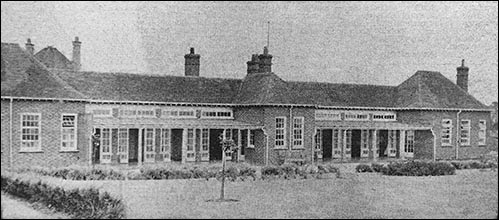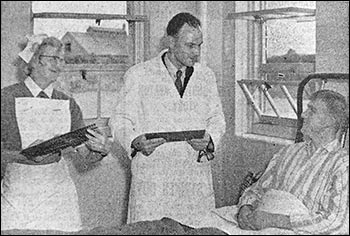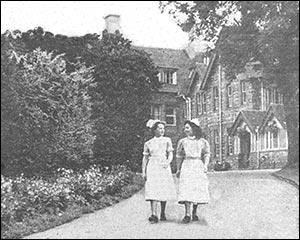The Rushden Echo and Argus, 2nd August 1957, transcribed by Jim Hollis
Research ‘drudgery’ has whacked the white scourge
Next time you count your blessings, reflect on this; though we endure the threat of the atom bomb and the reality of road crashes, we are living to see the virtual extinction of tuberculosis of the lung.
No longer do the young and beautiful go into a swift, unwavering decline. Gone from our speech are the words “galloping consumption.” No more does the “white scourge” lay low whole families.
Mass X-rays, new drugs and chest surgery are well on the way to beating tuberculosis of the lung. Today, only 20 people a year die from it in Northamptonshire and doctors are able to say that the number will steadily decrease.
What a change has taken place since the twenties and thirties – the black years. In 1930, 150 people died from lung T.B. in Northamptonshire. Worse the spread of the disease seemed uncontrollable by measures then available.
 |
|
The modern wards admit the maximum sun and air, and are surrounded by
delightful gardens in which the patients exercise. The wards are named after
people to whom the hospital is indebted for their work on its behalf.
|
Dreaded Then
Spearhead of the local treatment of the disease was Rushden Sanatorium, but the atmosphere that surrounded the “san” then was very different from today. Dr. Gilbert Lord, consultant at the sanatorium says himself that it was regarded with dread.
That was not surprising. As the most severe cases from the district were patients in the sanatorium many of the deaths took place there.
The sanatorium became the “unpopular” hospital with a macabre reputation that was quite unjustified. “Don’t go there,” people used to say. “You know what may happen if you do – you may not come out any more.”
“In those days,” Dr. Lord says, “there was little that could be done apart from giving the patient complete rest, trusting to his own resistance and perhaps occasionally collapsing a lung.”
 |
|
Smiles all round seem to show that things are going well.
Dr O E Fisher, one of the senior hospital medical officers,
on his rounds.
|
Different Now
Dr. Crane, in charge from 1922 to 1940, and his staff worked untiringly but it was uphill going the whole time.
The hopeless outlook for many lung tuberculosis patients a quarter of a century ago was reflected in the attitude of many general practitioners. They would say to workers in the T.B. field, Dr. Lord recalls:
“Why do you continue in this hopeless job? I suppose you do expect to get results sometimes?”
Fortunately for the nation the tuberculosis specialists of those days worked on finding and testing new techniques and hoping for better results.
See what a dramatic result has attended their labours. Lung tuberculosis has been almost beaten. Doctors look forward to the time when it will die out, apart from chance infection coming in from abroad.
The general improvement is reflected in Northamptonshire, where the boot factories only ten years ago had a bad reputation as haunts of lung tuberculosis.
Now things are very different. The disease has been banished from the staple trade, people who do contract it can be swiftly found by mass X-ray and treated early and the length of stay in hospital is much shorter.
Value of Mass X-Ray
This is how Dr. Lord explains the progress that has been made: “We are now obtaining the benefit of all the drudgery we did in the past in finding out how to tackle the disease.
“Mass radiography is the biggest single preventive measure we have ever had. It has unearthed a lot of infective cases so that we have been able to isolate them from home and factory contacts and so stop further damage by the spread of infection.
“The drugs in use today enable us to give the disease a knock-out blow. They have opened the way to an increased use of surgery, because the operation becomes safer.”
As result of the new methods Dr Lord observes it is no trouble at all to get patients to agree to enter the sanatorium.
“There is no dread of coming in now, simply because it has become fairly evident from the experience of others that patients will get on well and be back at work in a reasonable time.”
High Spirits
In the atmosphere of the sanatorium itself there has been a big change. Now that the disease can be detected early patients often do not feel ill. They are full of high spirits do not think of themselves as invalids, or see the necessity for careful treatment in bed at the beginning of their stay.
In fact it would not be going too far to say that the high spirits of the patients are at times a slight problem to the staff!
But, as any doctor will tell you this is all to the good. The attitude of mind has a great effect in cases of lung T.B. The happier a patient is the better. “It’s when they turn their faces to the wall that we begin to get really worried.” Dr Lord adds. “If they give up we can’t do anything.”
In practice, there are no face-to-the wall cases now. People want to get out and about again and the sanatorium does its best to see that they achieve this in record time.
As recently as the 1940’s, patients might be in bed for 18 months or two years and then fail to recover.
Almost a Certainty
Today for early cases, the usual stay is four to six months with almost a certainty of recovery. There has not been a death in the sanatorium from respiratory tuberculosis at all this year. In the old days there would have been 25 to 30.
All this has not been achieved without expense. In pre-war days expenditure per bed was about 33s a week. Now it is about £10, due to the cost of equipment, treatment, drugs, salaries and provisions. If we take inflation into account, this means that the costs have doubled.
But those few pounds a bed are repaid a million times in terms of health and happiness. Our debt to those who shouldered the drudgery of research half a lifetime ago and whose work has beaten the “white scourge” will never be repaid.
‘San’ Site is Pleasant Spot
Rushden House Sanatorium enjoys (as the guide books would say) a pleasant situation on a hill above the town. Once it was the house and gardens of Mr. Edward Campbell Browning, J.P., who moved there from Knuston Hall. He, his wife, and their three daughters were well-known Rushden personalities, although Mr. Browning’s business interests lay elsewhere.
Ruggedly built of local stone, the house itself looks much as it did when the family lived there. Wards have been built in the spacious grounds, but a big expanse of lawns and gardens remain.
The house was bought by County Council for use as a sanatorium in the early 1920’s and is amusing to recall, in the light of Rushden’s affection for the “san” that in those days townspeople were against it. Arguments were raised that the sanatorium would pollute the air and that it should be isolated in the country, but this antipathy soon vanished and was succeeded by enthusiastic support.
Many people played their part, but none more so than Dr. J. H. Crane, an Irishman whose bubbling kindly sense of humour did much to cheer patients, staff and voluntary workers. He was in charge for many years, and died in harness in 1940.
 |
|
Rushden House looks just as it was in the days when it was a residence and the gardens are kept at the same standard. It is now used as a nurses’ home and two of the nursing staff here add the finishing touch to the picture.
|
Rebuilding
The middle 1930’s were remarkable for a major rebuilding programme, which was completed during the first years of the war. Wooden pavilions which had served as wards were replaced by modern brick ones and a treatment block with x-ray and other apparatus was added.
The house itself serves as a nurse’s home.
Mainly the sanatorium’s 80 beds are devoted to chest cases but shortly a new unit dealing with skin complaints is to be established and will use a dozen of the beds.
Complaints dealt with in the chest wards are tuberculosis, bronchitis and allied troubles, and cancer of the lungs. Treatment at Rushden consists mainly of rest, supplemented by minor surgical work. If major chest surgery becomes necessary the patients go to the Creaton Sanatorium or the Peppard Chest Hospital at Henley-on-Thames.
When Cats Could Play
Cats are all very well in their proper place, but their proper place is NOT in the wards of Rushden Sanatorium. So decided the House Committee – and thereby hangs a tale.
Doors and windows of the “San” are open as much as possible, and word got around among Rushden’s stray cats that the patients were friendly folk who could be relied upon to hand out a spot of milk or a bit of meat to a casual feline visitor.
As a result, lots of cats called at the Sanatorium, made friends with the patients, and established themselves on the premises. By and by they even had kittens – as cats will.
This was where the House Committee decided to draw the line. The number of cats on strength, they decided, must be reduced. So the hospital handyman was sent round with a sack, with the object of capture and humane disposal.
Alas – so the story goes – there was not a cat to be found. The patients had heard of the impending purge, and had smuggled all their feline pals out of sight!
The next foray had to be a surprise!
|